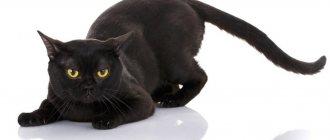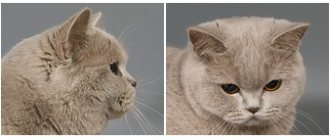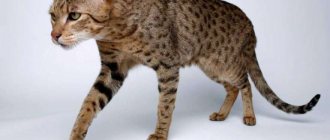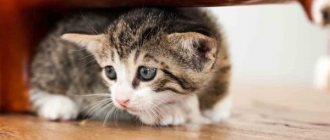The black Bombay cat has nothing to do with the ancient Indian city. She looks like a mini-panther, and owes her appearance to the crossing of two breeds - the Burmese and the American Shorthair. For superstitious people, this cat personifies something terrible, since its color from the tip of its nose to the pads on its paws is jet black. It is worth mentioning separately about the coat of the Bombay cat - its smoothness, shine and density, as well as its impenetrable ink color, are more reminiscent of patent leather than just short hair.
Americans even call representatives of the Bombay breed “shoe polish beauties with eyes like shiny copper coins.” Our compatriots, seeing this cat, will most likely exclaim in admiration: “Bagheera!”
Description of the Bombay cat breed
Popularity 49th place among 86 cat breeds
Lifespan:
12-15 years
Height:
25-30 cm
Country of origin:
USA
Average price:
35-40 thousand rubles
Weight:
3-5 kg
Latest articles Cat care
How to trim a cat's claws correctly and easily 01/28/2022 129 0 0
Dog health
How to do an ultrasound for dogs: preparation and procedure 01/28/2022 59 0 0
How to choose a kitten
First of all, you should know that the kitten must be completely black and with bronze eyes (if it is not of the British line).
The fur should be shiny, the tummy should be soft, the kitten should be active and playful.
It is imperative to check the pedigree - this breed has a hereditary craniofacial defect.
If you specifically need a Bombay cat, it would be most reasonable to buy one from a cattery, preferably with prior consultation with a specialist.
A true Bombay cat must be completely black. Any colored spots indicate a faulty breed
Key facts
The Bombay cat is called the “miniature panther” because of its predatory grace. In the look of an animal one can read the wisdom of many generations. The mysterious appearance of the Bombay is captivating - there are no light hairs or spots of other shades in the varnished short coat of the color of a raven's wing. Kittens are sometimes born with small brown spots, but during the moulting process, before they are one year old, they disappear completely.
Bombays' eyes are first blue, then gray, until 3 years old they are yellow-orange, and after 5 years they acquire a green tint.
Bombays are adapted to life at home: they are smart, affectionate, playful, easy to train, and love their owner. Description of the Bombay cat breed combines the activity of the American Shorthair and the extroverted features of the Burmese cat. It is unlikely that there will be another representative of the cat family with the same grace and appearance as a real panther.
Despite their “wild” appearance, Bombays are distinguished by their friendly, accommodating character, affection and devotion to their owners, and tolerance of small children and dogs. The animals are very smart, easy to train, have excellent health, and are unpretentious in their daily care and nutrition. They adapt very quickly to the new environment.
Characteristics of the Bombay cat breed include the following facts:
- The country of origin is considered to be America, the 50s of the 20th century. The cat breed was bred in the state of Kentucky; fanciers set themselves the goal of getting a miniature copy of the graceful panther.
- The Bombay's personality traits are a cross between the sociable, affectionate, playful Burmese and the kind, balanced, calm, intelligent American Shorthair cat.
- Care does not cause any difficulties. Frequent combing or haircuts are not required.
- If well maintained, the life expectancy of a Bombay cat is 19 years. Bombays live on average 12-16 years.
They are incredibly loyal, people-oriented animals that love to be the center of attention. If you prefer peace, then such features of the breed will be more likely to hinder than please - so it is better to choose someone else.
Bombay history
Nicky Horner crossed the American Shorthair and the Burmese in 1958, wanting to create an animal like a panther. The first litter was far from ideal in appearance. But she was persistent in her efforts. After some time, she finally managed to achieve her goal, and she received a mini-panther, which differs from its wild relative only in size. In 1970, the Cat Fanciers Association recognized the new breed. In 1976 she received the championship title. The outrage of Burmese breeders did not become an obstacle to this. By the mid-70s, Nicky Horner stopped working in this direction. But other breeders Herb and Suzanne Zwecker picked up the idea and continued working on the breed. They got the future champion Luv It Black with a perfect black color. It was she who changed the opinion about the breed. Her genes are in the pedigree of many representatives of the hybrid.
Nicky Horner wanted to create a small panther for herself.
There are not so many Bombay cats in the world. In 2000, the CFA registered less than 100 individuals, which allowed the breed to take only 34th place out of 40. Despite this, it was recognized in the WCF, ACF, CFA, TICA and ACFA.
History of the origin of the Bombay cat
Bombays as a breed originated in the USA. In the fifties of the 20th century, Nicky Horner visited an Asian country and was delighted with black panthers. After returning home, she set herself the task of breeding a unique breed of cats that resemble graceful and flexible predators.
To achieve this, sable Burmese were crossed with American shorthair cats. The experiment took about 5 years, and only in the 4th generation did “mini-panthers” appear with black fur like a raven’s wing and shiny copper eyes.
The year of registration of the new breed of Bombay cat was 1958. The cat aroused the admiration of many American breeders, who happily began breeding elite animals. In 1977, Bombay cats took part in the world championship and took 1st place, after which they became popular throughout the world.
In the Russian Federation, Bombays are considered an elite - rare and expensive breed. There are only a few nurseries in the country where unique animals are bred.
Breeding
Bombay cats are difficult to find, but there are several catteries dedicated to this breed:
- BLACK-LABEL – Novosibirsk.
- Murmurcat – Moscow and region.
- Mission - St. Petersburg.
Interesting Facts:
- The name of the cat was given not by a city in India, but by the creator of the breed, who sought to make the cats similar to Indian panthers.
- Bombays are allowed to be bred with Burmese and American Shorthairs, however, only a kitten with black fur will still be considered a Bombay.
Thus, the Bombay cat is a small panther with the character of a restless child. Such a cat can become an ideal companion for any family.
What does a Bombay cat look like?
This is a medium-sized animal, elegant, graceful, predatory with black and shiny fur, large gold-colored eyes. By adulthood, the Bombay cat gains weight of 2.6-5.6 kilograms.
Muzzle
As you can see in the photo, the Bombay cat's head is medium, slightly rounded. The muzzle is wide, with a pronounced but neat transition to the forehead. The nose is short, the chin is strong, the cheeks are full, the ears are rounded at the ends and set wide apart, tilted forward. The large eyes shine, resembling two gold-plated coins.
Body type
Bombays have an elongated body and a wide chest. The cats' musculature is well developed, the skeleton is massive. The neck is thickened and arched.
The fore and hind limbs are proportional to the muscles. The paws are slender, the front paws have five toes, the hind paws have four.
Bombays have a straight, strong tail, proportional in length to the body. A tail that is too short, long or crooked is a sign of an unclean breed.
Muscular animals reach 32 cm at the withers, females in adulthood weigh 2.6-3.6 kg, and males weigh up to 6 kg.
Coat and color
The Bombay's calling card is its thick, short, glossy, close-lying coat. The color of the Bombay cat demonstrates the elite nature of the breed - the animal does not have a single light hair, from the nose to the paw pads it is completely black. The exception is large, shiny amber eyes. There is practically no undercoat, which is why Bombays are great for people prone to allergies to wool.
There are 2 varieties of Bombay cats - British and American, which have a number of characteristic differences:
- “British” - representatives of the Burmese cat breed of the Asian group, obtained by crossing pets with characteristics similar to the Burmese cat;
- “Americans” are a mix of Burmese and American Shorthair cats.
British women's eyes are amber or yellow, American women's eyes are copper or dark orange. Bombay kittens are born with gray or blue eyes that turn copper or amber by 6 months.
Bombay cat kittens
Small kittens sometimes have light hairs on the surface of the coat, and the eyes are bluish or of an indeterminate color. Therefore, at an early age it is quite difficult to say for sure what an adult animal will look like, that is, whether it will be of show class or will remain just a pet. To be sure of the purity of the breed of the kitten you are purchasing, you should make a purchase only from trusted breeders, having previously examined the parents of a potential family member and familiarized yourself not only with them, but also with their pedigrees.
It is better to take a kitten into your home no earlier than he is 4 months old. Children of this breed develop slowly, and there is no need to rush to tear them away from their mother; it is better to reserve the baby you like and calmly wait for him to be taught everything, vaccinated and socialized. It should be taken into account that Bombay kittens love to eat, and nature has not built into them a limiter on the amount of food consumed.
Therefore, if you do not want to see a black bun instead of a graceful cat in your house, you will have to limit your pet’s food yourself, which a veterinarian can help with by developing a special diet and recommending a diet.
You need to raise a kitten gently, but strictly, using a spray bottle as punishment. Under no circumstances should you shout at the cat or spank it with your hand. If an animal does something that seems unacceptable to you, immediately spray it with a spray bottle and firmly tell it “ugh” or “no”. No angry emotions, screams or yelling!
No assault! Otherwise, instead of a friend, you will have an enemy in the house. Let him feel that despite all your love, the power in the house also belongs to you. Gently but firmly do what you think needs to be done. You will have more than 16 years of marriage ahead of you, and the more careful and attentive you are with your kitten from the very beginning, the better the results will be in the future.
Representatives of the Bombay breed are very clean and quite unpretentious in their choice of litter and litter box. They can use either wood, bentonite or synthetic filler. They will be satisfied even with the complete absence of one or with a newspaper placed in the tray. With some effort on the part of the owner, Bombay cats can easily master using the toilet.
Bombay cat personality
Bombays combine the balanced, calm disposition of the American Shorthair cat and the sociability and playfulness of the Burmese cat. The Bombay cat's personality is friendly, docile and loyal. Many pet breeders note that miniature panthers can make any person fall in love with their pleasant manner of communication, shiny coat and eyes glowing with amber light. Bombays require increased attention, do not tolerate loneliness, love affection, and are constantly near the breeder.
These cats are the first to run towards people entering the house, because they are sure that they have come to visit them. Bombays are active and incredibly curious: they explore the world around them with great pleasure, rarely giving up outdoor games. They respect all family members and get along well with children and dogs.
Character and behavior
The Bombay cat is a very balanced and peaceful creature. From her ancestors she inherited such traits as restraint, calmness, non-conflict and contact. All family members are her best friends. She does not single out a leader for herself, but on the contrary, she herself strives to take the dominant place in the house, but she does this very gently and unobtrusively.
She is quite a talkative person: her voice is an opportunity to convey her desires to others and share her problems. Females are more “chatty”, and their purring is much more melodic and gentle than that of males.
They get along well both in an apartment and in a private house. They don’t need a lot of space, but their own play corner is desirable. Buy a small play complex with pipes and shelves of different heights - this will be quite enough. In the warm season, it is advisable to take the animal for a walk. If you teach your pet to use a leash from early childhood, you will not have problems in the future.
Name the cat who always wanted to live together
BasilioLeopold
Bombay cats quickly establish contact with other cats and dogs, sometimes even becoming truly friends. But birds and small rodents are prey for them, so don’t be surprised why your cat sits for hours near a cage with a parrot, not taking its eyes off it.
Cats of this breed are lenient towards children: they can tolerate pranks for quite a long time, but at a certain moment they can crack their paws.
Bombays always run to meet guests, but at first they treat them very, very warily: after sniffing their hands, they won’t allow themselves more. And if a person has bad intentions, they will immediately feel it and will behave even more carefully and may show aggression: start hissing at the guest and hiding from him in a secluded corner.
Young Bombay residents are very inquisitive and love to stick their satin nose into all the nooks and crannies of their home, but with age they become more sedate, choosing an observation post somewhere on the windowsill or the back of the sofa, and observing those around them from there.
Raising a Bombay cat
Cats are naturally obedient. The authority of the owner is important to them, so they completely obey him and try not to make him angry or upset again. They are distinguished by caution, attention and gentle manners. Even in a game, Bombays will never break a fragile object located on the edge of the table. But much in such matters depends on the correct upbringing of the Bombay cat, which should be worked on from the first days the pet appears in the house.
Accustoming a kitten to your hands will not be difficult, since the animal loves tactile contact. But you shouldn’t play with the little “panther” with your hands - a predatory cat can scratch and bite them. It is better to use feathers or sticks with ribbons as toys. Leave your hands for encouragement - stroking and similar tenderness for obedience and good behavior.
No less attention should be paid to training the kitten to use the litter box. When he “does it” in the wrong place, the problem can be solved in 2 ways:
- The “crime scene” is thoroughly washed with strong-smelling solutions without chlorine (for example, vinegar) or special compounds that can be purchased at a pet store - this should scare away the animal and make it stop coping in the wrong place;
- the tray is placed in the place where the bombay is accustomed to relieve itself, and gradually moves (3-5 cm per day) towards the future location.
Punishments are also appropriate, but they cannot be harsh and severe. Spraying the offending animal with water has worked well. The reaction must be immediate - no later than 10 seconds after the offense. Otherwise, the pet may not understand the cause-and-effect relationship and may even harbor a grudge against the person.
Mr. Cat recommends: proper nutrition and health
It is enough to feed the Bombay 2-3 times a day, doing it at the same time. For this breed it is better to use premium dry food. A combination diet will not work, although you can sometimes pamper your cat with steamed lean meat. At the same time, the Bombay loves to eat, and if its diet is not controlled, it gains weight and becomes slow and lethargic.
You need to monitor the portions and vitamins that the animal receives. Protein should make up at least 80% of the daily diet, and it is better to allocate up to 20% for fiber. Don't forget that cats need vitamins. Specific medications are prescribed by a veterinarian; it is worth consulting with him on this issue.
Due to the characteristic structure of the nasopharynx (the absence of a clear transition between the forehead and nose), Bombays are characterized by diseases associated with the respiratory system and increased lacrimation. Such an animal is not allowed to be exhibited.
Bombay cat health
Bombay cats are naturally healthy and with proper care can live up to 16 years. But, like other animals, they can get sick.
Possible diseases
Unfortunately, even vaccinated and healthy pets from birth are not immune from various ailments. For Bombays, the following may occur:
- Common problems are: gum disease, respiratory failure, hypertrophic cardiomyopathy, accompanied by rapid heartbeat and shortness of breath. Such ailments require immediate contact with a veterinarian: proper treatment will alleviate the animal’s condition and prolong its life.
- A runny nose and lacrimation appear in an animal due to the specific structure of the nose. Solutions and drops prescribed by a veterinarian completely solve the problem in 3-5 days.
- Because cats have an excellent appetite, they often suffer from digestive disorders and obesity. You need to feed your pet a balanced diet according to the recommended standards.
It is important to give your pet all the necessary vaccinations on time and to constantly perform antihelminthic prophylaxis - and then the health of the Bombay cat throughout its life will not be a cause for concern.
Reproductive health
Breeding Bombays is an art. The first estrus in females begins at 6-8 months and lasts 5-7 days. If during this time the Bombay cat does not become pregnant, estrus repeats after 2 weeks. Professional breeders recommend performing the first mating no earlier than 1 year of age; the best time for this is the fourth day of estrus.
No less attention is paid to choosing a partner. The owner needs to determine for himself: he wants to satisfy the natural needs of the animal or continue the family of a purebred pet. In the second case, you will need an “ideal groom,” which means you will have to search for an experienced breeder or a cattery with clean cats. Veterinarians recommend giving birth no more than once a year, otherwise the female’s body will weaken, she will become thin, and her immunity will begin to fail.
If you do not plan to breed a cat, castration is required - an operation to remove the genitals. During sterilization, the veterinarian only ties the fallopian tubes - hormones continue to be produced, and sexual desire is preserved. After castration, the pet becomes more balanced and calm, its reproductive system is completely protected from the development of diseases.
Surgery is performed by a surgeon in specialized clinics. The cat is not fed for a day; it is brought in advance, after which the doctor takes all the necessary tests. Abdominal surgery is performed under general anesthesia.
Puberty, mating
Bombay cats reach sexual maturity at 6–9 months, although by this time the body and organism are not yet fully formed. Final development occurs only by two years - this is a very decent period. Despite this, some cats give birth as early as 5 months. If mating is not planned, it is better to resort to castration and sterilization; the procedure is carried out in the 6–9th month of the pet’s life.
Mating is carried out on the territory of the male. The Bombay cat's pregnancy lasts 63–70 days from the moment of mating. There are rarely more than four kittens in one litter.
There are rarely more than four kittens in one litter
Features of feeding and diet
Bombay kittens eat a lot. It is better to buy them balanced food with additives and nutrients.
If you prefer natural feeding, you should include in your pet’s diet:
- oatmeal, buckwheat, wheat porridge;
- quail, chicken raw yolk;
- offal;
- beef, veal;
- dairy products;
- sea fish without bones;
- vegetables (eggplant, carrots, zucchini).
Important! A complete Bombay diet should include 80% protein and 20% everything else.
Vaccination
When kittens are three months old, they can be taken for their first vaccination. After this, after some time, revaccination is done. The second vaccination is given after six months, it is important to get it before eight months. The remaining vaccinations are in accordance with the schedule drawn up by the veterinarian.
Before vaccination, deworming is carried out. The procedure takes place at least a week before vaccination.
Care and maintenance
If you got a Bombay for home, and not for exhibitions or breeding, then the waste of time and effort will be minimal. Otherwise, caring for and maintaining a Bombay cat will require a more careful approach. You definitely need a rubber brush for carding wool and a special shampoo, as well as teeth cleaning supplies.
A common eye problem in Bombay - increased lacrimation - can be eliminated with rinsing solutions, which are sold in a regular pharmacy. You can also use a cotton swab dipped in weak black tea.
Bombay cats do not like walks in the fresh air - extraneous sounds make them anxious. The most comfortable environment is in a home where pets feel completely protected.
Toys for miniature “panthers” should be as safe and bright as possible; hanging tunnels and labyrinths will not be superfluous.
Diseases
Artificially bred Bombay cats are in good health, but are susceptible to hereditary diseases. One of them is hypertrophic cardiomyopathy. Hereditary include possible deformities in the skull area.
Watery eyes and gum inflammation are also common in Bombay cats.
A pronounced “stop”, which is associated with a curvature of the nasal passage, leads to a runny nose and stuffy nose. Therefore, the cat must be protected from drafts.
Tips for choosing a kitten
It is better to buy a fully formed 16-week-old Bombay, since up to this age kittens have blue eyes and brown coat color. It is simply impossible to guess what they will become. For this reason, exhibition specimens are purchased closer to the age of 5-6 months.
- Preference should be given to specialized nurseries, where the pet receives all the necessary documents (including a veterinary passport with vaccinations and birth certificate).
- Private breeders often turn out to be unscrupulous people who claim that their Bombay kittens have a pedigree, but in fact they turn out to be ordinary yard cats.
- No less attention should be paid to external indicators: the ears should be clean, the eyes should be clear, the tail should be even, without kinks, the coat should have a satin sheen, the kitten should be active in play.
Be prepared for the fact that this is a “companion” who will always be close to his breeder. If you like loneliness, it is better to give preference to another breed.
Catering
Bombays love to eat and lick their bowls until they shine. But too much food will turn from an elegant and graceful animal into a clumsy bun, suffering from shortness of breath, palpitations, diabetes, or worse. Therefore, remember the following:
- The cat must not be overfed! Adult animals (over six months old) eat 2 times a day: morning and evening. An exception can be made for lactating and pregnant females, sick or elderly animals. Teenagers 4-6 months eat 3-4 times, babies – 5-6.
- The animal should be switched to a new food gradually, and not suddenly change the diet. Apart from indigestion, this will not bring any benefit.
- You cannot mix natural food and ready-made food: choose one.
- Your cat should have separate bowls for water and food. It is advisable to wash the dishes after each meal so that they do not stagnate and become saturated with an unpleasant odor.
- Be sure to clean drinking water from harmful impurities and chlorine. A regular faucet filter will help with this. Or you can leave the liquid in a jar without a lid for 8-12 hours in a dark place.
Natural products
The following natural products are allowed:
- Meat. Only low-fat varieties: rabbit, turkey, veal, beef. The meat is pre-frozen, and before feeding it is thawed and doused with boiling water to destroy possible parasites. They feed the meat every day, cutting it into pieces 1-2 cm long. Fat layers, bones, and skin are removed. The exception is chicken necks: they are ground into minced meat along with cartilage.
- Fish. Salmon families: chum salmon, pink salmon, salmon, river trout. Or lean (if the cat is on a diet): blue whiting, cod, hake. All sharp parts, bones and fins must first be removed. It is also undesirable to give heads and milk. The fish is boiled for at least 20 minutes in unsalted water and given once a week. More often it is impossible - excess fish leads to the development of urolithiasis.
- By-products. This is an additional source of minerals and vitamins. Liver, hearts, ventricles - boiled or raw.
- Dairy products. Low-fat cottage cheese, natural yogurt without dyes and other additives, kefir, fermented baked milk, yogurt, low-fat sour cream.
- Eggs. Chicken ones are boiled and only the yolk is given to the cat (the protein gives the cat diarrhea), quail ones are fed whole.
- Porridge. Buckwheat, rice, oatmeal, barley. Porridge can be included in the diet when the kitten is 1.5 months old: first they are cooked in milk, and then in vegetable or meat broth. You can feed porridge every other day in the proportion of one part porridge to 3 parts meat.
- Vegetables. No more than 10% of the daily food intake. Zucchini, carrots, broccoli, asparagus, green beans, celery, beets. You can’t give them raw ones – the cat might choke! The exception is cucumbers and melons. They perfectly quench thirst. The hard skin can be removed.
It is prohibited to give:
- Pork and pork by-products (contains histamines), goose, duck and lamb (poorly digested), fresh liver and raw lung (causes diarrhea and vomiting), minced meat from the store (it often contains skin and fat);
- Corn, pea, millet porridge, semolina (it is acceptable to feed babies liquid semolina porridge with milk), instant porridge;
- Avocado, garlic, onions, grapes, raisins (and dried fruits). Potatoes cause constipation, so you should be careful with them;
- Sweet, smoked, salty, flour, baked goods;
- Dog food;
- Human vitamins;
- Tea, coffee, cocoa, whole cow's milk, mineral and sparkling water, juices, compotes.
Recommended food
Among industrial feeds, holistic and super-premium class feeds are considered the best. These are Fitmin Purity, Go Natural, Arden Grange. The rest - food from the economy and premium groups - are made from meat waste (rather than pure meat), contain chemical preservatives, dyes and flavor enhancers, which, naturally, will not benefit the cat.
Below are the recommended holistic and super-premium foods. Links with the names of the food are clickable, on them you can, within our website, get acquainted with the descriptions of the food and read reviews from the owners of the Bombay cat breed.
| Holistic | Holistic | Super premium |
| Canagan | Gather | Bozita |
Activity
The Bombay cat is a very active, nimble and self-confident animal. It loves to get attention, poke its nose in and have fun in every possible way. Therefore, the pet must be provided with a large number of toys. Particular attention should be paid to devices for the development of intelligence and physical activity (labyrinths, cat trees, etc.).
Mini panthers love to spend time with their owner. Therefore, they get great joy from playing together and learning tricks. Of course, such a pet will not be able to bring slippers in its teeth, but smaller things are easy.
Bombay cats also have a well-developed hunting instinct, despite their aristocratic appearance and grace. These amazingly active and dexterous animals are excellent at catching mice when necessary. Some individuals even eat them with pleasure.
Coat color
The color of a real Bombay should be jet black. Light hairs and spots are not allowed. The Bombay cat in the photo is painted black from ears to paws. The pads on the paws and nose should also be black. The presence of sable shine is important. The eye color is always copper. Let's say the iris has a golden hue. The Bombay cat of the British subspecies may have green eyes.
Interesting!
A Bombay cat can have other colors if it was bred by crossing with American shorthair breeds of marble color (in Russia, in Moscow there are simply no black American shorthair cats). The result is a ticked color, as in the photo below. Recently, pets with different colors have begun to be bred more and more often.
Photo and video
Photo:
Video:
Video: Bombay cat
Video: Bombay cat everything about the breed. Interesting Facts
Video: Bombay cat is one of the rarest cat breeds in Russia
The Bombay domestic panther is a wonderful pet with unique characteristics. The animal has a calm and positive character. The owners leave positive reviews already in the first days after meeting. This is a true friend and family member who will take an active part in the life of the household. Leave your feedback about this exotic breed.











